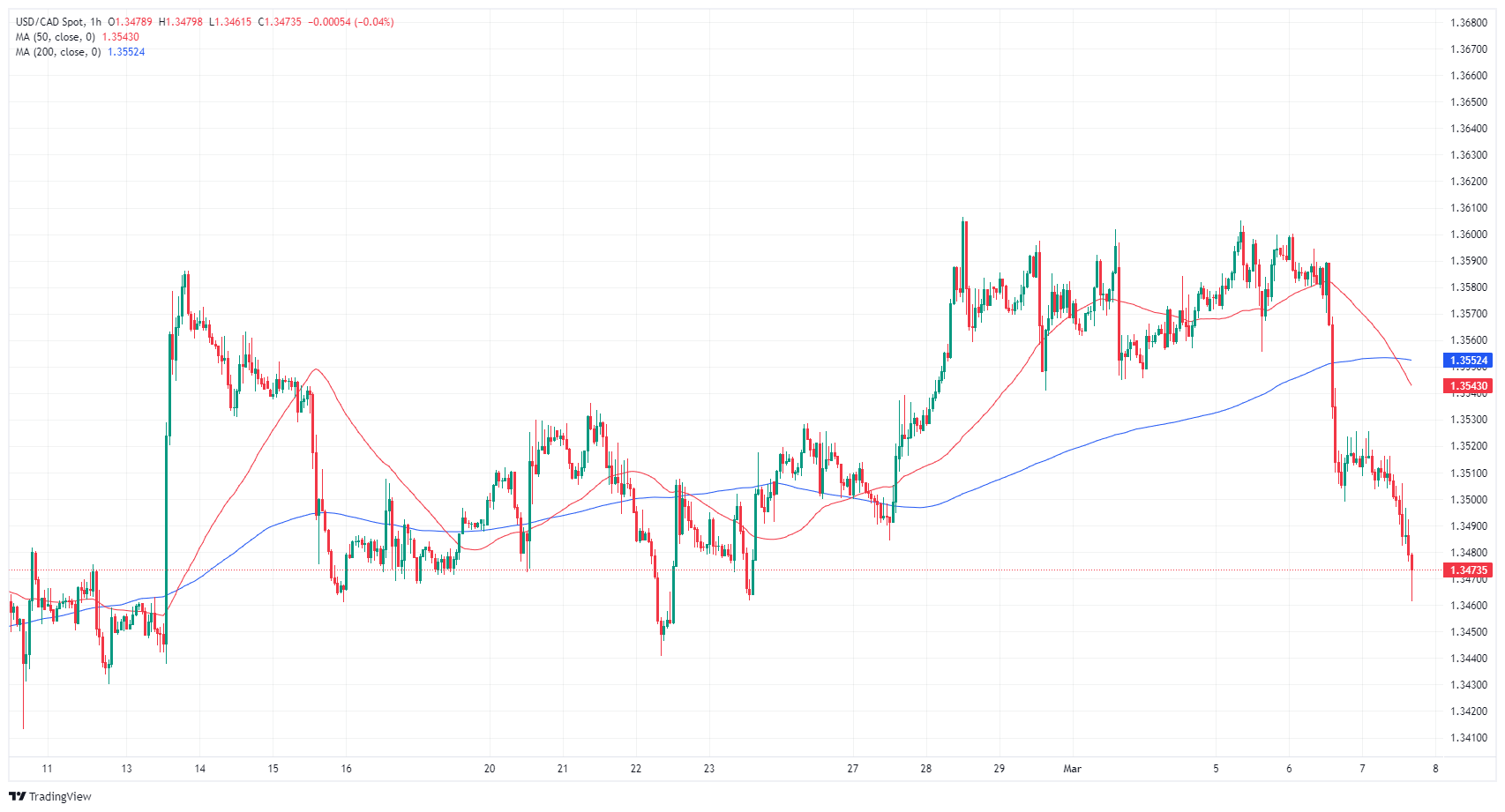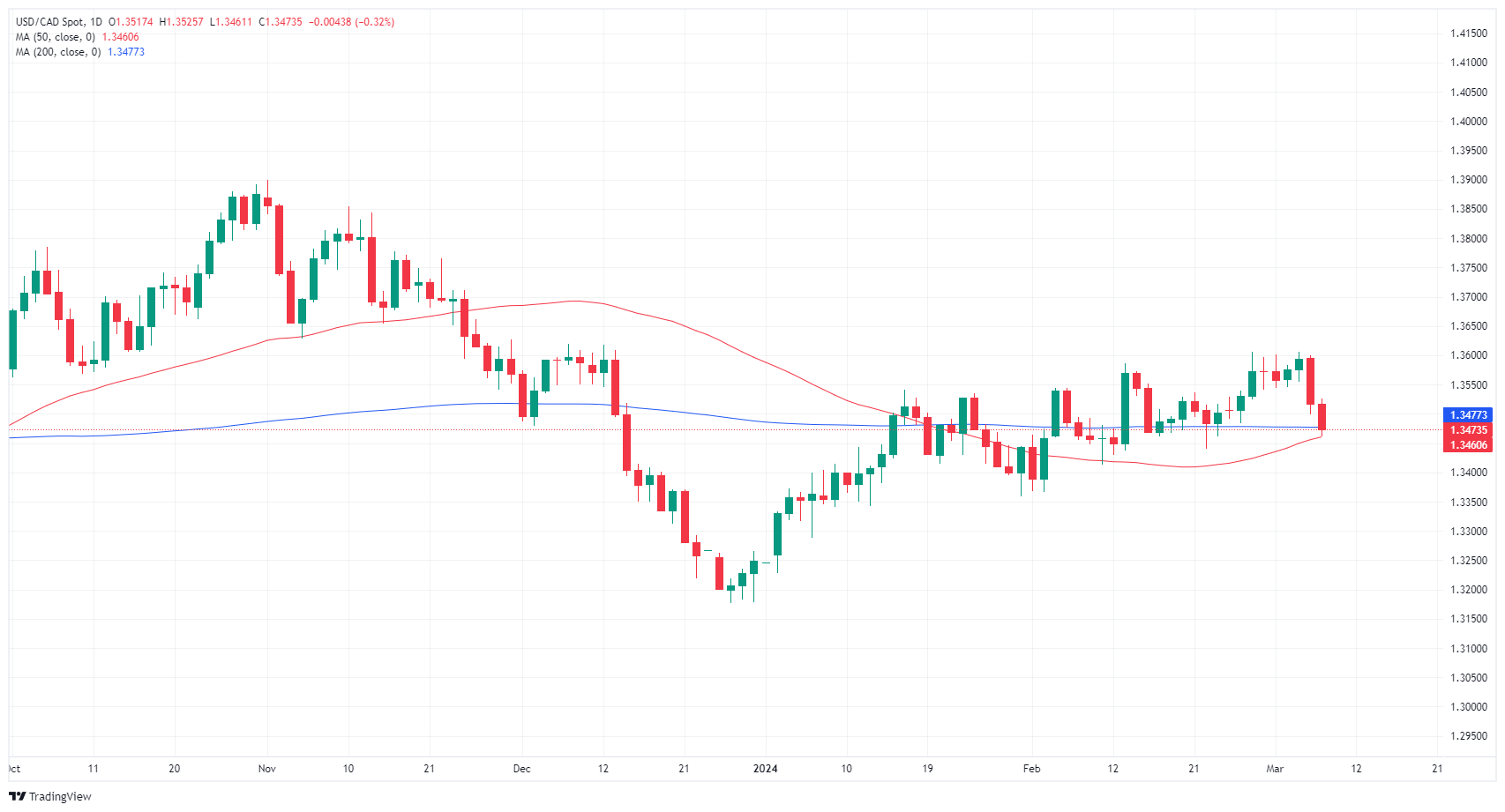- Phân tích
- Tin tức và các công cụ
- Tin tức thị trường
- Canadian Dollar extends higher against weakening Greenback on Thursday
Canadian Dollar extends higher against weakening Greenback on Thursday
- Canadian Dollar mixed on the day but climbs over US Dollar.
- Canada brings its own labor figures to US NFP Friday.
- USD/CAD breaks down below 1.3500 on weaker Greenback flows.
The Canadian Dollar (CAD) found some room on the high end above the US Dollar (USD) on Thursday. The USD/CAD pair slipped below the 1.3500 handle as markets buckle down for the wait to Friday’s US Nonfarm Payrolls (NFP) jobs report.
Canada answers the US NFP print with labor figures of its own on Friday. American markets will be switching to Daylight Savings Time this weekend, while Canada will be largely absent from the economic calendar with strictly low-tier data on offer next week. However, plenty of US data will arrive to drive the markets, with February’s US Consumer Price Index (CPI) inflation slated for next Tuesday.
Daily digest market movers: Markets pull away from Greenback as investors await key data
- Canada’s MoM Building Permits jumped to a seven-month high of 13.5% in January, well above the 5.5% forecast and recovering from the previous month’s -11.5% decline (which was revised upward from -14.0%).
- US Initial Jobless Claims for the week ended March 1 printed slightly above expectations, coming in at 217K versus the forecast 215K, while the previous week saw a revision to 217K from 215K.
- Initial Jobless Claims came in above the four-week average of 212.25K.
- US Nonfarm Productivity in the fourth quarter held steady at 3.2% compared to the forecast of a tick lower to 3.1%.
- US Q4 Unit Labor Costs ticked down to 0.4% from the previous 0.5%, missing the forecasted uptick to 0.6%.
- Federal Reserve (Fed) Chairman Jerome Powell testifies before the US Senate Banking Committee in the second of a two-day Q&A about the Fed’s Semi-Annual Monetary Policy Report.
- Canada’s Unemployment Rate is expected to tick higher from 5.7% to 5.8% on Friday.
- Canadian Net Change in Employment in February is forecast to print at 20K versus the previous month’s 37.3K.
- Friday’s US NFP print is expected to come in at 200K for February, down from January’s 11-month peak of 353K.
- NFP Preview: Forecasts from 10 major banks, employment continues to rise strongly.
Canadian Dollar price today
The table below shows the percentage change of Canadian Dollar (CAD) against listed major currencies today. Canadian Dollar was the weakest against the Australian Dollar.
| USD | EUR | GBP | CAD | AUD | JPY | NZD | CHF | |
| USD | -0.35% | -0.45% | -0.33% | -0.77% | -0.77% | -0.70% | -0.46% | |
| EUR | 0.35% | -0.10% | 0.02% | -0.42% | -0.40% | -0.35% | -0.11% | |
| GBP | 0.45% | 0.10% | 0.13% | -0.32% | -0.32% | -0.26% | 0.00% | |
| CAD | 0.34% | 0.00% | -0.12% | -0.44% | -0.43% | -0.38% | -0.13% | |
| AUD | 0.77% | 0.42% | 0.33% | 0.45% | 0.00% | 0.05% | 0.32% | |
| JPY | 0.77% | 0.41% | 0.30% | 0.41% | -0.02% | 0.06% | 0.28% | |
| NZD | 0.68% | 0.35% | 0.25% | 0.37% | -0.07% | -0.06% | 0.24% | |
| CHF | 0.45% | 0.11% | 0.01% | 0.13% | -0.31% | -0.30% | -0.25% |
The heat map shows percentage changes of major currencies against each other. The base currency is picked from the left column, while the quote currency is picked from the top row. For example, if you pick the Euro from the left column and move along the horizontal line to the Japanese Yen, the percentage change displayed in the box will represent EUR (base)/JPY (quote).
Technical analysis: USD/CAD drifts into the low side as Greenback waffles
The Canadian Dollar (CAD) found room above the US Dollar on Thursday, climbing around a third of a percent against the Greenback, but overall the Loonie is moderately softer across the broader FX market. The CAD lost around half a percent against the Japanese Yen (JPY), the Australian Dollar (AUD) and the New Zealand Dollar (NZD). The Canadian Dollar is flat against the Euro (EUR) as both currencies struggle to find moves.
USD/CAD found a near-term floor at 1.3500 on Wednesday, and Thursday’s US Dollar-bearish flows finished the job, knocking the pair toward 1.3460. The Dollar-Loonie pair is down around a full percent from the week’s peak bids at 1.3605.
Thursday’s decline drags the USD/CAD pair back into the 200-day Simple Moving Average (SMA) at 1.3477, and the immediate technical floor is priced in at the last meaningful swing low toward 1.3350.
USD/CAD hourly chart
USD/CAD daily chart
Canadian Dollar FAQs
The key factors driving the Canadian Dollar (CAD) are the level of interest rates set by the Bank of Canada (BoC), the price of Oil, Canada’s largest export, the health of its economy, inflation and the Trade Balance, which is the difference between the value of Canada’s exports versus its imports. Other factors include market sentiment – whether investors are taking on more risky assets (risk-on) or seeking safe-havens (risk-off) – with risk-on being CAD-positive. As its largest trading partner, the health of the US economy is also a key factor influencing the Canadian Dollar.
The Bank of Canada (BoC) has a significant influence on the Canadian Dollar by setting the level of interest rates that banks can lend to one another. This influences the level of interest rates for everyone. The main goal of the BoC is to maintain inflation at 1-3% by adjusting interest rates up or down. Relatively higher interest rates tend to be positive for the CAD. The Bank of Canada can also use quantitative easing and tightening to influence credit conditions, with the former CAD-negative and the latter CAD-positive.
The price of Oil is a key factor impacting the value of the Canadian Dollar. Petroleum is Canada’s biggest export, so Oil price tends to have an immediate impact on the CAD value. Generally, if Oil price rises CAD also goes up, as aggregate demand for the currency increases. The opposite is the case if the price of Oil falls. Higher Oil prices also tend to result in a greater likelihood of a positive Trade Balance, which is also supportive of the CAD.
While inflation had always traditionally been thought of as a negative factor for a currency since it lowers the value of money, the opposite has actually been the case in modern times with the relaxation of cross-border capital controls. Higher inflation tends to lead central banks to put up interest rates which attracts more capital inflows from global investors seeking a lucrative place to keep their money. This increases demand for the local currency, which in Canada’s case is the Canadian Dollar.
Macroeconomic data releases gauge the health of the economy and can have an impact on the Canadian Dollar. Indicators such as GDP, Manufacturing and Services PMIs, employment, and consumer sentiment surveys can all influence the direction of the CAD. A strong economy is good for the Canadian Dollar. Not only does it attract more foreign investment but it may encourage the Bank of Canada to put up interest rates, leading to a stronger currency. If economic data is weak, however, the CAD is likely to fall.
© 2000-2024. Bản quyền Teletrade.
Trang web này được quản lý bởi Teletrade D.J. LLC 2351 LLC 2022 (Euro House, Richmond Hill Road, Kingstown, VC0100, St. Vincent and the Grenadines).
Thông tin trên trang web không phải là cơ sở để đưa ra quyết định đầu tư và chỉ được cung cấp cho mục đích làm quen.
Giao dịch trên thị trường tài chính (đặc biệt là giao dịch sử dụng các công cụ biên) mở ra những cơ hội lớn và tạo điều kiện cho các nhà đầu tư sẵn sàng mạo hiểm để thu lợi nhuận, tuy nhiên nó mang trong mình nguy cơ rủi ro khá cao. Chính vì vậy trước khi tiến hành giao dịch cần phải xem xét mọi mặt vấn đề chấp nhận tiến hành giao dịch cụ thể xét theo quan điểm của nguồn lực tài chính sẵn có và mức độ am hiểu thị trường tài chính.
Sử dụng thông tin: sử dụng toàn bộ hay riêng biệt các dữ liệu trên trang web của công ty TeleTrade như một nguồn cung cấp thông tin nhất định. Việc sử dụng tư liệu từ trang web cần kèm theo liên kết đến trang teletrade.vn. Việc tự động thu thập số liệu cũng như thông tin từ trang web TeleTrade đều không được phép.
Xin vui lòng liên hệ với pr@teletrade.global nếu có câu hỏi.















